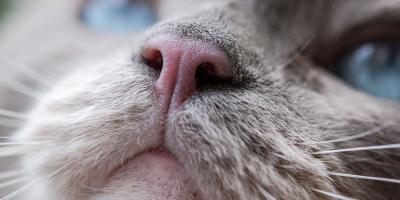Yeast Infections in Cats: Common Causes, Symptoms & Treatments


Yeast infections in cats can be caused by two common yeasts. The most common yeast-causing infection is Malazzezia, which is present normally in low number on the skin and in the ears of cats. Another species that less commonly causes infections is Candida albicans. This yeast is part of the normal flora in a cat’s mouth, nose, gastrointestinal and genital tracts. An infection from Candida albicans (called Candidiasis) is typically associated with animals who are immunosuppressed.
Both yeasts serve a purpose in your cat’s bodily system. But when these naturally occurring yeasts become overgrown, they cause a yeast infection.
What is a Yeast Infection in Cats?
Can cats get yeast infections? Yes, even though yeast is a normal part of a cat’s body. Small amounts of yeast and bacteria form the normal flora of your cat’s skin and ears.
If yeast is a normal part of the body, what causes yeast infections in cats? An infection can happen when the skin barrier is damaged allowing the yeast to invade. Underlying causes that can damage the skin barrier include (but are not limited to) allergies to the environment or food, trauma, and infections from other organisms.
The yeast grows to abnormal levels and can infect a specific part of the cat’s body like the ear causing an ear infection (i.e., otitis externa). This infection can be extremely uncomfortable for pets.
What Causes a Cat Ear or Paw Yeast Infection?
How do cats get yeast infections, and are they contagious? Anything that damages the skin barrier can predispose a cat to a secondary yeast infection. Trauma to the skin from injuries, burns, other infectious organisms, and allergies can inflame the skin. Yeast infections are generally not contagious to other animals or people in contact with the animal. Additionally, chronic conditions and compromised immune systems can also be contributing risk factors.
Cat Yeast Infection Symptoms
A cat’s yeast infection symptoms can depend on the location of the infection. With a cat ear yeast infection, you may observe:
- Dark brown or black waxy debris in the ears
- Brown discoloration of the hair
- Pruritis – itching
Cats with yeast ear infections will also show irritability and head shyness. They may shake or scratch their heads and lower their ears.
Symptoms of cat paw yeast infection include:
- Red and itchy paws
- Accumulation of brown waxy debris in the claw folds
- Brown discoloration of the claws
You may notice your cat will lick his or her paw pads excessively due to itching and that the nail bed appears to be swollen and red. Some cats may shake their feet repeatedly as if their paws are wet.
With both infections, your cat will be very itchy. Pruritis, or itching of the skin, caused by yeast infections will not respond to allergy treatments. The infection must be treated directly.
Yeast infection symptoms from Candida albicans typically depend on where the infection occurs and are typically associated with cats that are immunocompromised. Cats may present with nonspecific signs like decreased appetite, weight loss, fever, and gastrointestinal signs. Fortunately, infection from this type of yeast is uncommon.
Diagnosing a Yeast Infection in Cats
Your vet may suspect a yeast infection after examining your cat, but because some bacterial infections can mimic yeast infections, skin scrapings from the affected area or ear swabs may be required. The samples can be looked at under a microscope to identify the yeast.
Is it cat ear mites or a yeast infection? Fungal infection can be secondary to an ear mite infestation. Ear mites, also known as otodectic mange, are caused by mites that infest the external ear and cause inflammation. Ear mite symptoms are similar to a cat’s yeast infection symptoms. Cats will shake their heads, scratch their ears, and hold their ears down. The mites make a dark, thick, stinky mess in the cat’s ears.
Cat Yeast Infection Treatments
Your vet will know how to treat yeast infections in your cat’s ears or paws. The first step is to visit your vet for diagnosis and treatment. There are several veterinary infection treatments available depending on the type of yeast and level of infection. While you may hear or read about cat yeast infection home remedies, we recommend discussing those treatments with your vet first.
Your vet may prescribe oral and topical antifungal medicines, or a combination of both. If your cat also has a bacterial infection, antibiotics may also be prescribed. You will probably need to continue the medicine at home, so if you’re unsure of how to administer the treatment, ask your vet to show you. It’s crucial to keep treating the infection even after symptoms clear up to ensure the yeast is thoroughly in check.
Treatment for ear mites in cats begins with a thorough cleaning. This should be done by the vet to avoid hurting the cat’s ear drums or ear canals with the swab. Then your vet will prescribe topical, oral, or systemic medicine. Most likely these will include ear drops to get rid of the mites. Left untreated, the mites can cause secondary infections that can damage the ear.
Watching your cat scratch, shake, and itch from a yeast infection is unsettling. That’s why at the first sign of an issue, you should take your cat to your vet for a proper diagnosis of the skin condition. Together, you and your vet can develop and manage a successful treatment plan that will resolve the yeast infection and help your cat stay healthy.
Want more cat health tips? Get advice from our experts with our other cat health articles.
Related articles

Earn myPurina Rewards with Every Purchase
Use your points for treats, toys, and gift cards with myPurina app.



